Learn how to turn an old rusty cast iron skillet into a well-seasoned pan with this step-by-step guide!
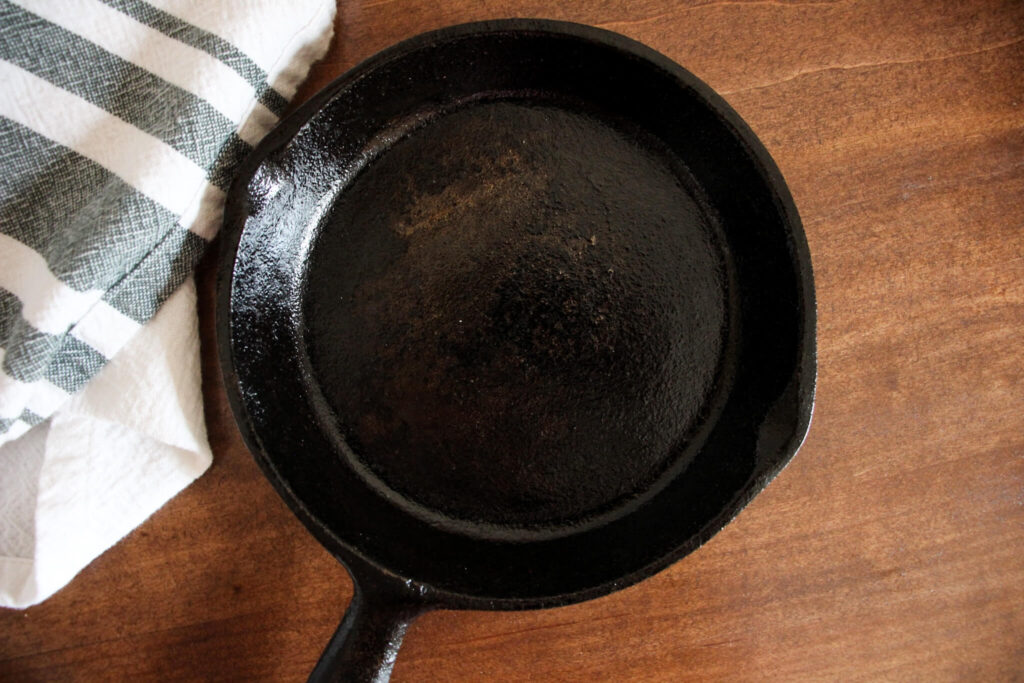
I love cast iron. In fact, for the last four years, I’ve exclusively used only cast iron cookware and a few stainless steel items in my kitchen. I love how versatile cast iron can be, as well as how durable it is. As long as you maintain cast iron, it can span generations. And even when neglected, cast iron can be restored to its former glory pretty easily. You can turn a rusty cast iron pan into a well-seasoned, fully functional piece of cookware with a little bit of elbow grease and a bit of oil. In this tutorial, I’ll guide you through the restoration process of an old cast iron skillet!
PIN FOR LATER!
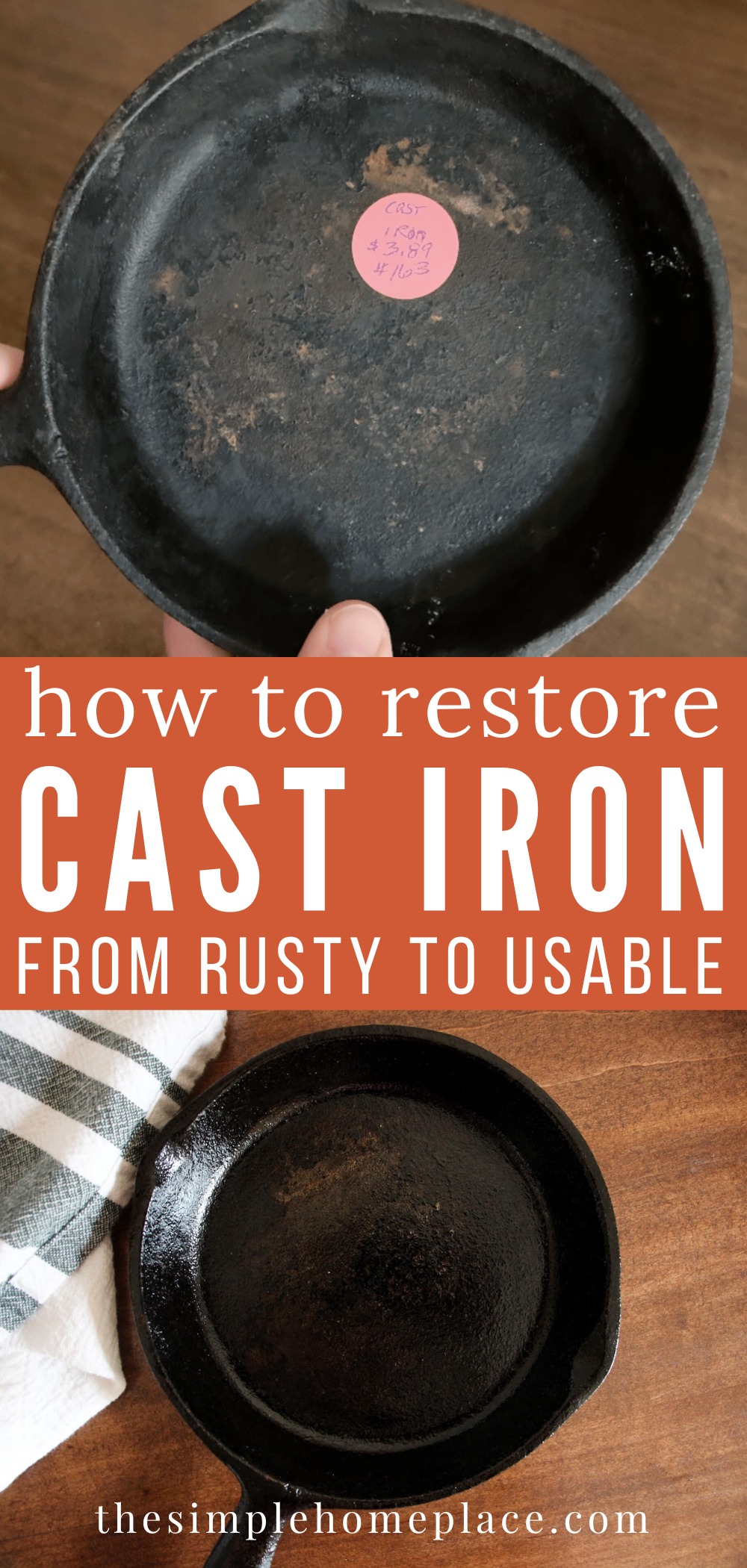
My Favorite Cast Iron Cookware
- Lodge Dual Handle 12 inch Cast Iron Skillet
- Lodge 10 inch Cast Iron Skillet
- Lodge 8 inch Cast Iron Skillet
- Lodge Griddle
- Lodge Dutch Oven
FAQs
Where do I find vintage cast iron?
You can find old cast iron cookware in a lot of places including thrift stores, consignment stores, at a garage sale or flea market, antique stores, et cetera. Garage sales, thrift stores and flea markets will probably yield the cheapest prices, but you never know. I found this particular pan at a consignment shop for less than $4!
What causes cast iron to become rusty?
Cast iron gets rusty when it’s exposed to water for too long. For instance, soaking a pan in water and not properly drying and seasoning it can cause rust. However, the better the seasoning on the pan, the less likely it will rust, at least not as quickly. Regardless though, if not cared for properly, cast iron will rust. That’s why it’s important to dry and season your cast iron every time its washed. As a note, acidic foods like tomato sauces, can cause the seasoning layer to start to diminish, so it’s important to cook acidic foods sparingly and ensure your pans are properly washed and seasoned after cooking those foods.
Can a rusty cast iron pan be used again?
The beauty of cast iron is that it’s super resilient and can be brought back to life pretty easily. All it takes is a little elbow grease and some oil, and it’ll be back in business. Now, the difficulty of restoring your rusty pan will be determined by the amount of rust present on the surface of the pan and otherwise. Small spots of rust can be easily cleaned using the method shown in this post, but if there’s a lot of surface rust, it may take more work.
What oils are best to season a cast iron pan?
When it comes to choosing an oil to season your cast iron, you want to look for oils with a high smoke point or high burning point. Below are a list of some of the most popular options. I prefer to use either beef tallow or olive oil for my pans since I always have them on hand and they work great to help creating a beautiful non-stick surface.
- Olive oil
- Avocado oil
- Grapeseed oil
- Canola or vegetable oil
- Bacon grease
- Tallow
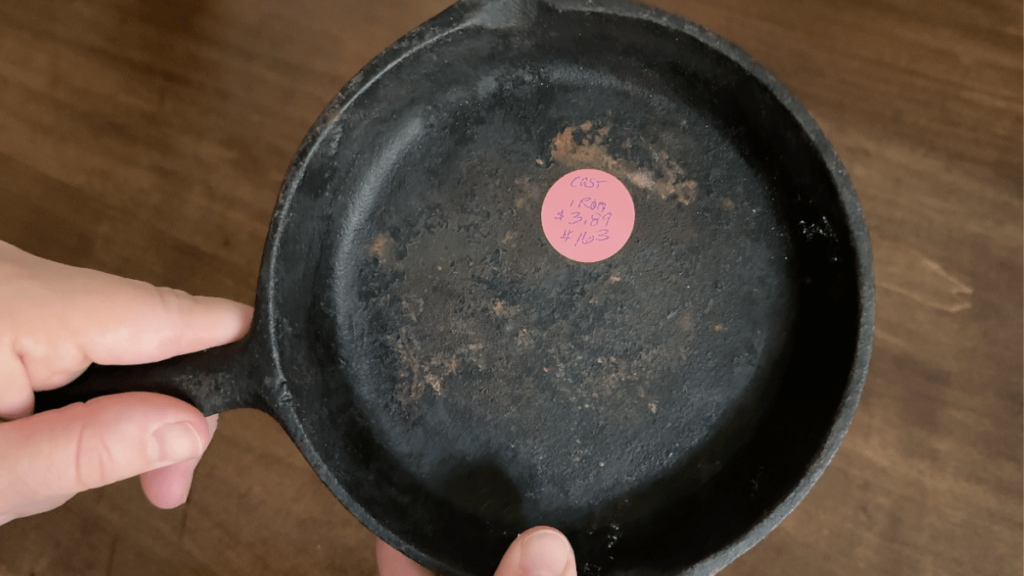
This post may contain affiliate links, which means I may receive a commission, at no extra cost to you, if you make a purchase through a link. Please see our full disclosure here for further information.
How to Restore and Clean Old & Rusty Cast Iron
Tools You May Need:
- Wire brush or steel wool (optional depending on how rusty the pan is)
- Pan scraper
- Baking sheet
- Lint-free cloth or paper towel
- Rust eraser
Materials Needed:
- Distilled white vinegar
- Dish soap
- Oil of choice
Directions
Step 1: Vinegar Soak
When I brought home my new cast-iron pan, the first thing I did was I allowed the pan to soak in a 50-50 solution of distilled white vinegar and hot water. I made sure the entire pan was submerged and I allowed it to soak for about 30 minutes, but you could go for about an hour. I used my kitchen sink, but you could also do this in a large bucket or container, depending on the size of your cookware.
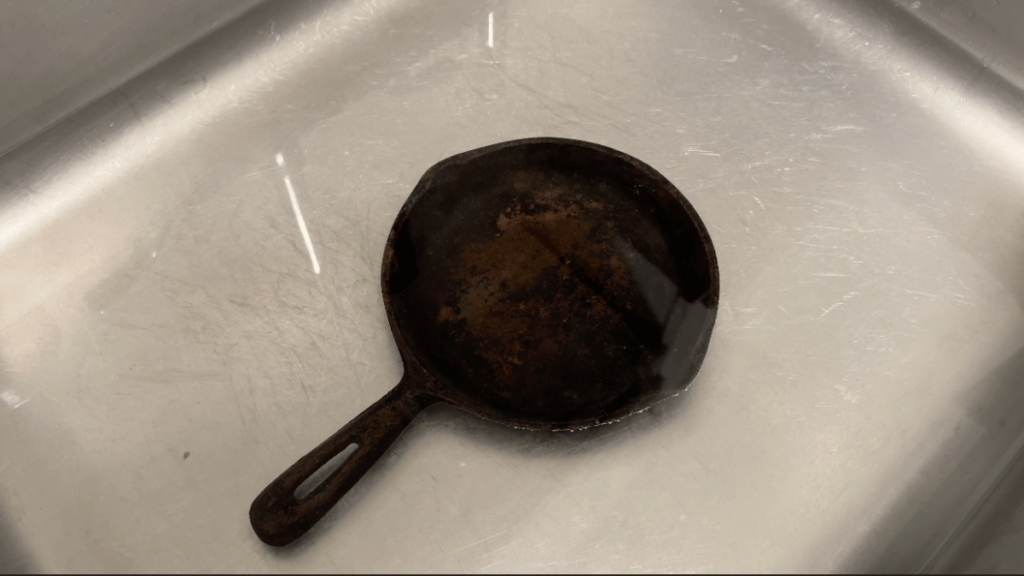
Step 2: Rust Eraser
Next, I dried the pan well, then used my rust eraser to remove any rust present on the surface. Luckily this pan had very minimal rust, but this tool works really well at stripping down the rust and seasoning in spots that need it. If you don’t have a rust eraser, you could also use a wire brush or steel wool to achieve a similar result.
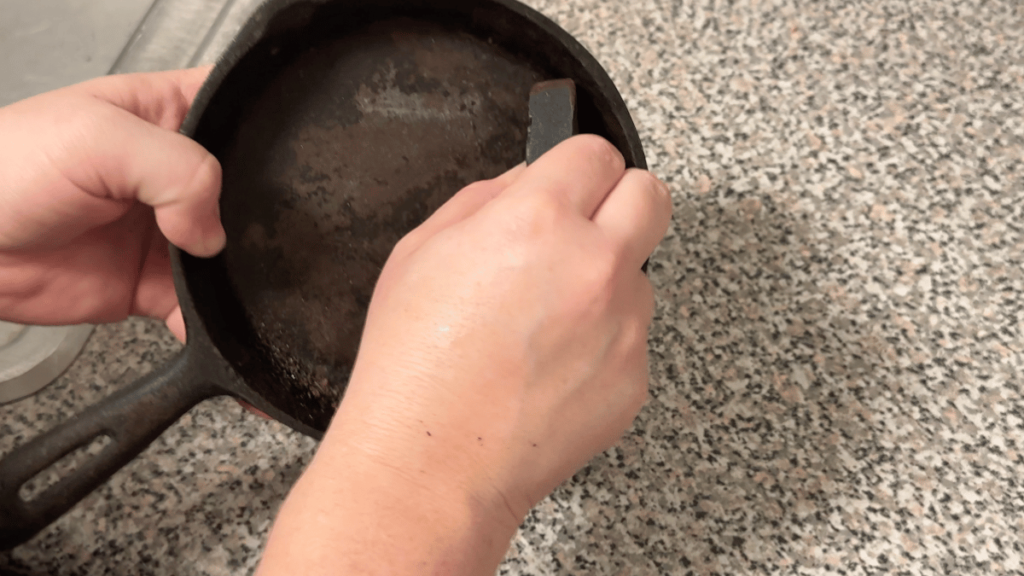
Step 3: Clean and Scrub
I used warm water, some dish soap, a strong-bristled brush and kosher salt to scrub the pan well to get it nice and clean.
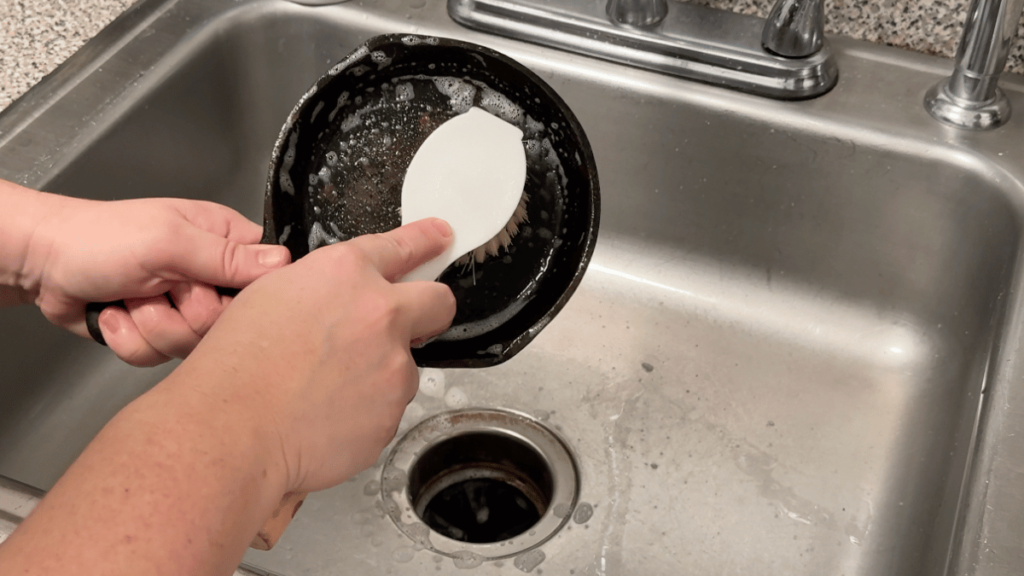
Step 4: Season on the Stovetop
Once it was nice and clean and free of rust, it was time to season. I place the dry pan on the stovetop and turned the burner to low heat. I added a small amount of oil to the pan and used a paper towel to coat the entire surface, including the bottom and the handle and remove any excess oil. You only want a thin layer of oil, otherwise the pan will become sticky in the seasoning process.
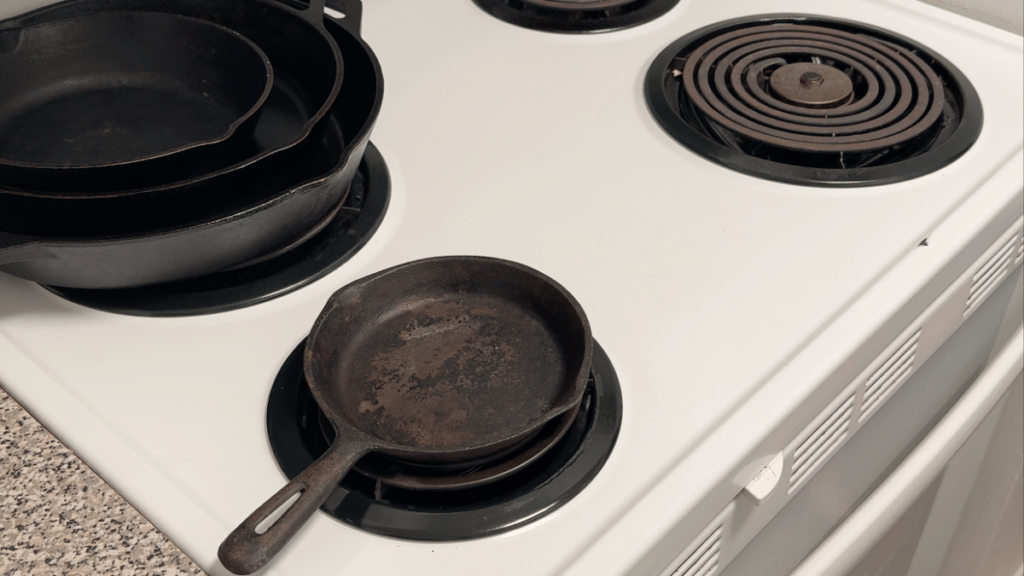
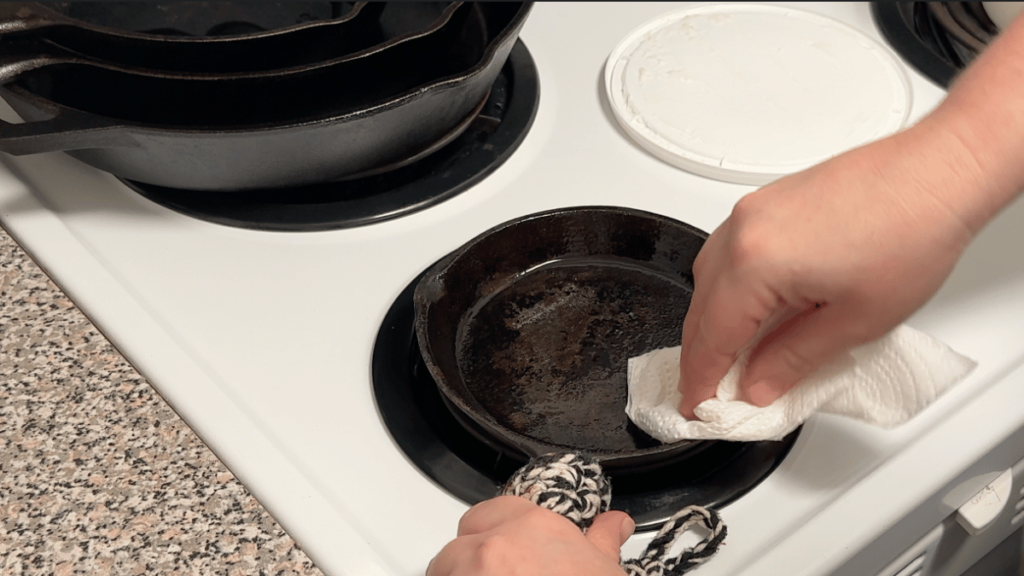
Step 5: Season in the Oven
Once the pan was coated in oil, I placed the pan upside down on the top rack of a preheated oven (375°f) and added a cookie sheet on the bottom rack to catch any oil that may drop, although there really shouldn’t be any. I baked the pan for 1 hour, then shut off the oven and allowed it to cool for about an hour. Then I repeated the process a few times to get a good seasoning.

How to Care for Cast Iron
I have an entire post dedicated on how to clean and season cast iron, but here’s a Cliff’s Notes version:
- After you’re done cooking, wash the pan with soap, water and a scrub brush. You may need to also use a scraper to get off any baked on bits.
- Ensure the pan is free from any food residue.
- Wipe the pan pan dry with paper towel or a dish towel.
- Place the skillet on the stovetop and set the heat to low-medium and allow the pan to heat up and dry out completely. This will take a few minutes.
- Once the pan is warmed up, remove it from the burner.
- Add a small amount of your preferred oil to the pan and rub it all over the entire surface of the pan, removing any excess oil.
How to Store Cast Iron
I like to store my cast iron skillets in a stack on top of my stove, but you could also store them in your oven, in the drawer beneath your oven, in the pantry, in a cupboard, on the wall. There’s really many options and you have to determine what works best for your kitchen, but the main thing you need to be conscious of is whether or not water or moisture is present. So store them wherever works for you, just make sure it’s a clean and dry environment.
Looking for more cast iron tips?
Looking for more info on cooking with cast iron? Check these out:





Leave a Reply